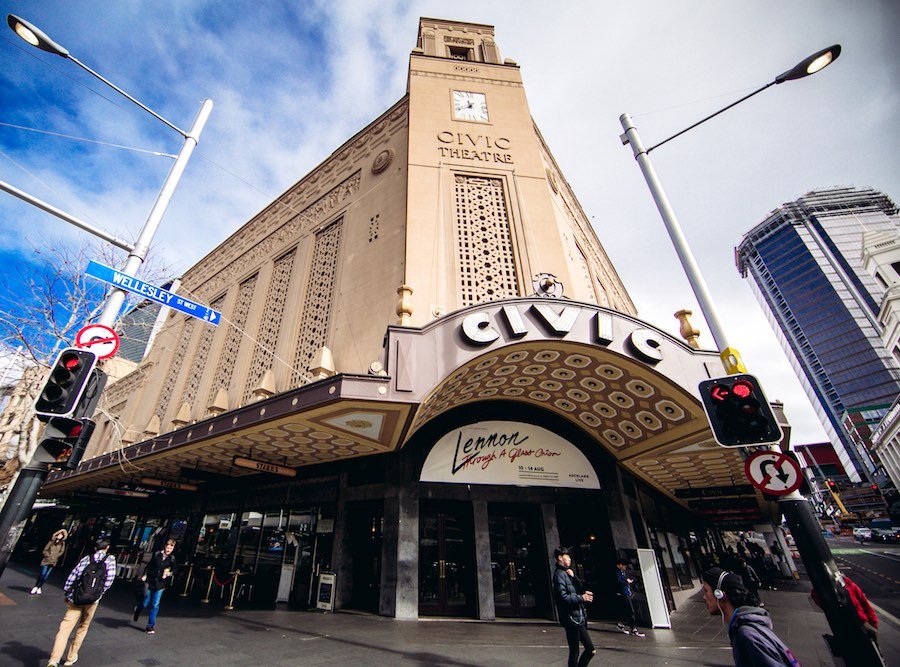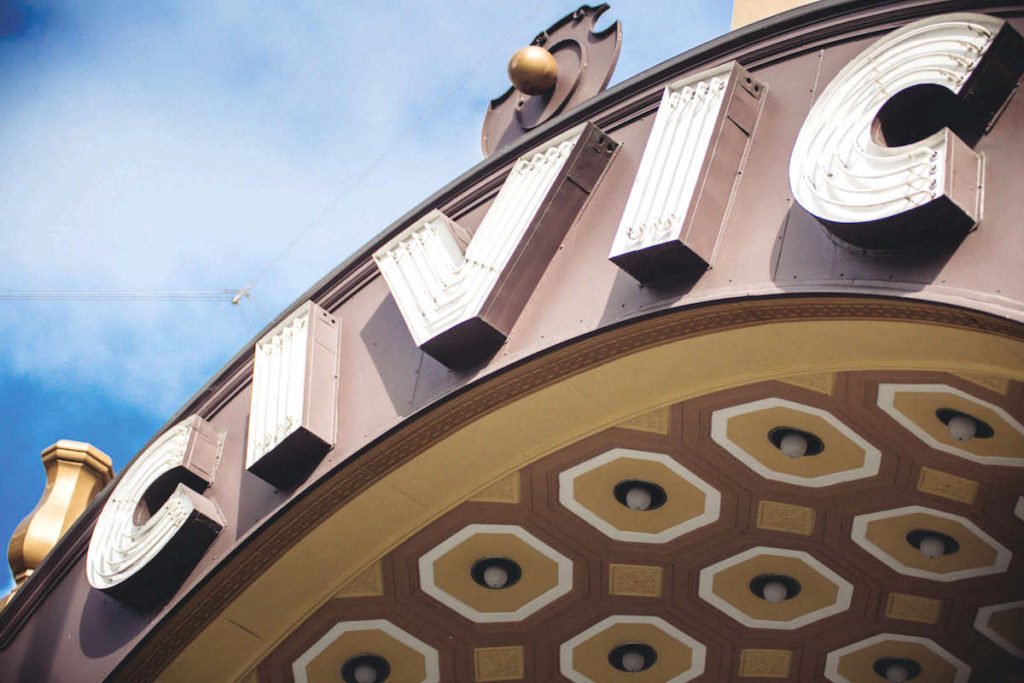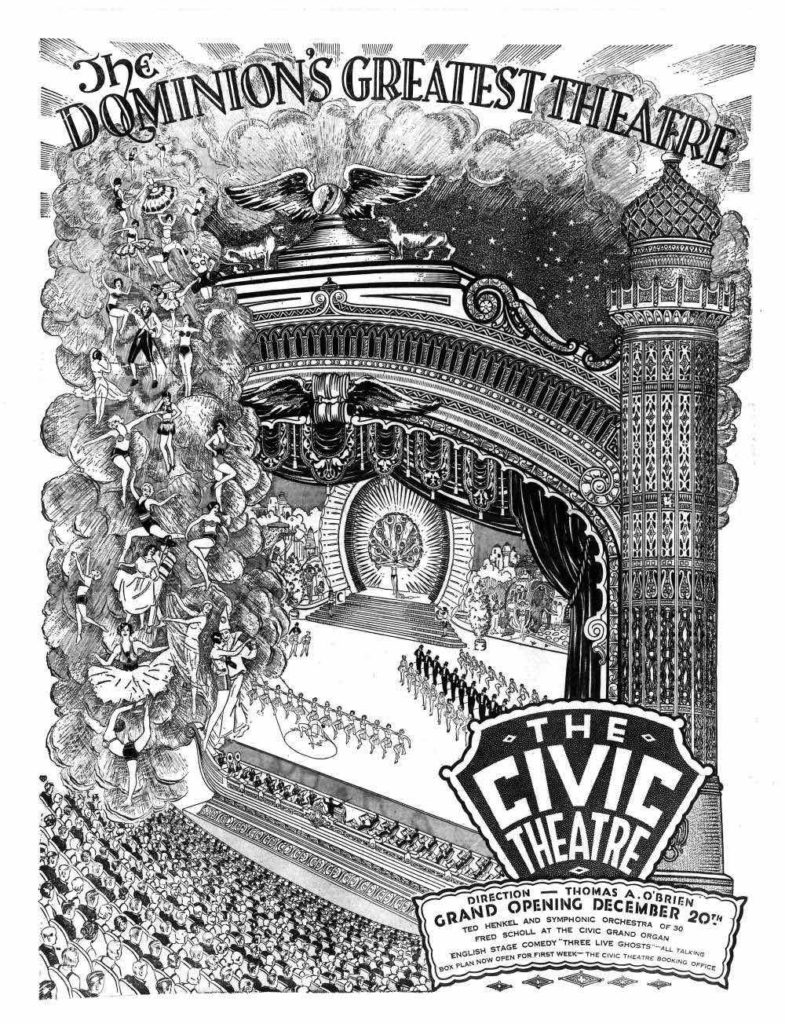News
21 Feb 2020
The Civic Roars into the Twenties

Subscribe to CX E-News
The Civic Roars into the Twenties – Auckland’s Civic Theatre Turns 90
On 20th December the grand old lady of drama, musicals and cinema, The Civic, turned ninety on a definite high. Near derelict in the 80s she was almost demolished to make way for a train station but is now roaring into the 20s, a globally significant exemplar of cinematic and theatrical history.
The Civic is an ‘atmospheric’ theatre, a style popular in the late 1920s, predominantly in the USA but with a few others scattered around the world, including Sydney’s Capitol Theatre and Dunedin’s Empire Theatre, now a six screen Rialto.
Atmospheric theatres were designed and decorated to evoke the feeling of a particular time and place through the use of projectors, architectural elements and ornamentation with twinkling stars and drifting clouds across the ceiling.
Japanese, Aztec, Moorish, Egyptian, and Roman influences abounded, often combined in a garish mish-mash.
The Civic’s Eastern theme, with Indian-inspired motifs in the public foyer including seated Buddhas, twisted columns and domed ceilings is supplemented in the main auditorium by Spanish courtyard turrets, minarets, spires, tiled roofs and not forgetting the Abyssinian panther statues for extra kitsch.
By the 1980s the majority of atmospheric theatres were severely compromised or demolished and only a handful remained. At 2,800 seats, The Civic was one of the largest anywhere in the world, but neglected and under threat.
It is testament to the power of a campaign group and a well-placed passionate individual that The Civic lives on, not only as a venue but as a part of history.
George Farrant, an architect, was the right man in the right place at exactly the right time. Whilst assessing and ranking heritage buildings in downtown Auckland to inform the Council’s urban planning, George became aware of The Civic’s national and international significance.
“Working with The Friends of the Civic, we got the backing of councillors to restore it to its former glory and $42 million to spend.”

The decision was made to assimilate live theatre, requiring a new stage, fly tower and all the necessary equipment and technology, but George and the Friends also fought to preserve The Civic’s cinematic roots.
Although Auckland Live (then The Edge) had doubts, the now 2,379 seater venue was packed out within two weeks of the theatre’s 1999 re-opening with people flocking to see Blade Runner – The Director’s Cut and the touched up version of Gone With The Wind.
For George this is what he relishes most about his heritage work, “I enjoy the dual challenges of trying to integrate the new technologies, whilst preserving what is unique about a building.”
One of his biggest challenges at The Civic was recreating the ubiquitous starry ceiling and the cloudy sky, “The sky was a notorious acoustic reflector. Someone would start a monologue and you’d only hear the first three words before the echo would drown out the rest of the speech.
“It had to be replaced and person after person told me that it had to be a replica of the original; the Southern sky at night.”
“The original starry sky had been created using tiny little lightbulbs designed for use in aircraft control panels peeping through holes in the ceiling,” explains George. “They were 9 volts but ran at 6 volts to extend their life, changing a light bulb being a heroic feat!”
With most of the wiring destroyed by pigeon droppings, George was unable to just turn on the lights to look at the supposedly accurate map. Instead he had to stuff each hole with paper, take photos and then compare it to a map of the sky.
“Turns out it was not a map of the Southern sky at all, just completely random.”
“After the Council gave us some extra money, we decided to put back what everyone thought they had been looking at rather than what they had been looking at and replicate the actual Southern sky at night.”
George chose the night sky from 20th April at 10pm when the Southern Cross is high and Orion, Scorpio and the Milky Way are very visible.
“We now have five times as many stars as in the old ceiling, thirteen with colour and all positioned accurately to two decimal places. We used fibre optics and have enabled them to all twinkle individually.”
The team also managed to resurrect the old cloud projection machine, even down to sourcing a replacement for the misappropriated lens, and supplemented it with a new projector. Lastly they decided to add a shooting star.
This required an invisible slit in the ceiling and 320 white LED pilot lights. The University of Auckland designed a circuit that would strobe and pulse the LEDs along the slit, with a bright flare at the start, fading out along its journey.
“Initially we had the meteor programmed to run just the once, two minutes into the sequence but we had complaints that people missed it. We now run it two times, a minute apart, but if you miss the second one it is hard luck!”
Maintenance lighting was another challenge for George and his commitment to preserving the integrity of the venue as an atmospheric theatre.
“We needed five lux of lighting for maintenance work. We knew what we didn’t want due to lessons learned at the Capitol Theatre in Sydney, where they had used twelve watt halogen bulbs in amongst the stars. Only problem was they didn’t look like stars.”
The Lighting Engineers advised that twenty five to thirty 1500 watt lights would create the required amount of light, but they needed six inch holes.
George was not going to have six inch holes in his ceiling. Instead he undertook a survey and identified that a thirty millimetre hole was beyond the vision of most people so that was what they would work with.
“We made chrome plated funnels to fit the six inch lights into, then the light barrelled down this fitting and out through a thirty millimetre hole, invisible to the naked eye.”
And of course live theatre often needs extensive stage lighting not just from the fly tower directly above, but also from the auditorium ceiling.
“The idea of obtrusive lighting booms with masses of fittings below our magnificent electronic starry sky just wasn’t on.”
George and his team elaborated on a solution that he had used in the recently restored Auckland Town Hall, “I had the big ‘follow spots’ mounted above the ceiling that were exposed for use by raising a large trapdoor in the ceiling, so that if they were not needed there was no evidence that they even existed.
“The Civic lighting problem was of course much more significant, so
we designed a series of very large hatches, big sections of the ‘night sky’, that are down, complete with stars, when the sky is displayed, but then as the stars and clouds dim to black they whisper up on near-silent cable lift mechanisms to reveal masses of stage lighting and follow-spots.
“The lift mechanism also had to be able to smoothly drape all the star fibres inside caterpillar tracks as the hatches move.”
George recalls with great satisfaction hearing theatre patrons exclaiming in astonishment, after just having admired the night sky, “Where the hell did all those lights just come from?”
It was a large team of committed and passionate individuals who made George and the Friends of The Civic’s dream possible, George describing himself as “the conductor of a large and talented orchestra.”
George particularly recalls the contribution of Peter Stoneham of Fibre Optics Ltd, the clever services design developed by Jasmax Architects and The Edge, even down to the Fine Art students who helped with the paint restoration.
Many of these same individuals are now waiting in the wings for the go ahead to restore the St James Theatre, another Auckland treasure, once the politics is out of the way.
To this day George, now aged seventy-seven, continues as a consultant to Auckland Live, who manage The Civic with Regional Facilities Auckland, “Auckland Live are very good custodians and will never authorise anything without talking to someone first to measure the impact.”
When big shows want to drill holes in the ceiling it is always run past George.
“I’ll try and work with the production team and although I might say no to what they want to do, I’ll offer an alternative, but we are not like other theatres and can’t be horsed around with. Welcome to The Civic!”
With spectacular audience attendance figures and recent hits such as Matilda the Musical, Mary Poppins, Disney’s Aladdin, School of Rock and with The Book of Mormon opening in February, Auckland Live and George’s approach seems to be paying dividends.
“It is hard to believe that now we worry about finding the time to fit in maintenance work or backstage theatre tours, so popular is the venue.”
Definitely worthy of a 90 year celebration.
George Farrant takes groups backstage for fascinating three hour tours when he gets the chance between shows and saving historical buildings. See the Auckland Live website for details.
CX Magazine – February 2020
LIGHTING | AUDIO | VIDEO | STAGING | INTEGRATION

Entertainment technology news and issues for Australia and New Zealand
– in print and free online www.cxnetwork.com.au
© VCS Creative Publishing
Subscribe
Published monthly since 1991, our famous AV industry magazine is free for download or pay for print. Subscribers also receive CX News, our free weekly email with the latest industry news and jobs.











































